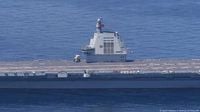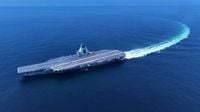On September 12, 2025, China’s newest and most technologically advanced aircraft carrier, the Fujian, sailed through the Taiwan Strait for the first time, drawing global attention and stirring a mix of anticipation and concern across East Asia and beyond. The carrier’s voyage, which the People’s Liberation Army Navy (PLAN) described as a routine cross-regional test and training exercise, marks a pivotal step as the vessel nears official commissioning—a move widely seen as a significant leap in China’s ongoing naval modernization.
The Fujian’s journey began with its departure from the Jiangnan Shipyard in Shanghai on September 10, 2025, following maintenance after its eighth sea trial in May. According to Japanese officials, the carrier was spotted the next day sailing southwest in the East China Sea, about 200 kilometers (124 miles) northwest of the disputed Senkaku Islands—known as the Diaoyu Islands in China—accompanied by two guided-missile destroyers, CNS Hangzhou and CNS Jinan. Japan’s Ministry of Defense Joint Staff Office confirmed this was the first time its forces had observed the Fujian at sea, highlighting the region’s heightened vigilance.
China’s navy was quick to frame the carrier’s transit as a normal part of its construction process. PLAN spokesperson Senior Captain Leng Guowei stated, “The cross-regional tests and training are a routine mission of the carrier’s construction process and do not target any specific objects,” as reported by Chinese state media and echoed by Xinhua News Agency. The Fujian was bound for the South China Sea to conduct further scientific research trials and training missions, a region recognized for its complex maritime environment and frequent geopolitical tensions.
The timing and route of the Fujian’s maiden journey through the Taiwan Strait—a narrow body of water separating mainland China from the self-governing island of Taiwan—were not lost on international observers. The strait is a flashpoint in regional security, with the United States and some of its allies regularly sending warships through the area to signal support for Taiwan and freedom of navigation. While China’s navy insisted the carrier’s activities were not aimed at any specific target, analysts and officials in neighboring countries were quick to interpret the move as a demonstration of China’s growing military might.
Collin Koh, a senior fellow at Singapore’s S. Rajaratnam School of International Studies, told AFP that the transit was meant to “flex China’s newfound military strength and send a veritable signal to potential adversaries.” He added, “It’s to signal China’s rise as a strong military power, and beyond that, a maritime great power.” This sentiment was reflected in regional responses: Taiwan’s Ministry of National Defense said it had used “joint intelligence, surveillance and reconnaissance means to fully grasp the situation and responded accordingly,” while Japan’s defense ministry noted the potential impact of China’s intensifying military activities on its own security.
The Fujian stands apart from its predecessors—the Liaoning, commissioned in 2012, and the Shandong, which entered service in 2019—not only in size but in technological sophistication. At 80,000 tonnes, the Fujian is China’s largest carrier to date and the first in the country to feature an electromagnetic catapult system. This advanced technology, previously only seen on the U.S. Navy’s USS Gerald R. Ford, allows aircraft to take off with greater payloads and more fuel, offering a significant operational advantage. The system uses linear motor technology, which, as described by USNI News, is similar to the mechanisms that drive monorails and high-speed roller coasters, reducing the number of crew required for launch operations and minimizing maintenance compared to older steam catapult systems.
Ray Powell, a maritime expert and former United States Air Force Colonel, told Al Jazeera, “China is closing the hardware gap, but developing the operational expertise for effective blue-water carrier ops is what the US has spent nearly a century perfecting.” Powell noted that while the Fujian’s technological leap is impressive, the real challenge for China will be building the necessary operational experience and dividing veteran crew members among its now three-carrier fleet.
The Fujian’s air wing is expected to be formidable, comprising up to 40 fixed-wing aircraft and a dozen helicopters. The fixed-wing complement is anticipated to include the J-35 stealth fighter, the J-15T fighter, J-15DT electronic attack aircraft, and KJ-600 Airborne Early Warning and Control (AEWC) planes. These capabilities are expected to significantly enhance China’s ability to project power and conduct sustained operations far from its shores, a hallmark of so-called “blue water” navies.
China’s rapid naval expansion has not gone unnoticed. The U.S. Department of Defense reported in December that China now possesses the world’s largest navy by number of ships, with a battle force exceeding 370 ships and submarines. Beijing’s ambitions to challenge U.S.-led alliances in the Pacific are evident, with both the Liaoning and Shandong conducting combat drills in the western Pacific earlier this year. According to Taiwan’s Ministry of National Defense, Beijing deployed its two carrier groups around the island in May, further stoking regional anxieties.
Despite official statements insisting that the Fujian’s tests and training are not directed at any specific country, the symbolism of its transit through the Taiwan Strait is unmistakable. The move comes at a time of heightened tensions, with China refusing to rule out the use of force to assert sovereignty over Taiwan, which it views as a breakaway province. The United States, while not officially recognizing Taiwan’s government, continues to provide weaponry for its defense and advocates for a peaceful resolution to cross-strait differences.
The carrier’s commissioning date remains undisclosed, but speculation abounds that it will coincide with a date of historical significance to China—such as September 18, marking the anniversary of the 1931 Manchurian Incident, or October 1, the national day of the People’s Republic of China. The state-owned Global Times suggested that, based on the Shandong’s timeline, the Fujian could be officially put into service by the end of the year, following the completion of its rigorous sea trials in the challenging conditions of the South China Sea.
As the Fujian nears operational status, the world is watching closely. For some, its debut signals the dawn of a new era in China’s maritime ambitions; for others, it’s a sobering reminder of the shifting balance of power in the Asia-Pacific. Either way, the Fujian’s voyage through the Taiwan Strait is more than a test run—it’s a statement of intent, and one that will echo far beyond the waters it traversed.

